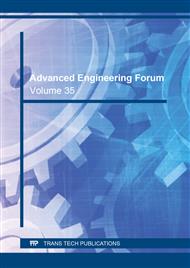[1]
Deng, Z.; Carlson, T. J.; Ploskey, G. R.; Richmond, M. C.; Dauble, D. D. Evaluation of blade-strike models for estimating the biological performance of Kaplan turbines. Ecological Modelling, 208(2), 165–176. (2007).
DOI: 10.1016/j.ecolmodel.2007.05.019
Google Scholar
[2]
Zivkovic, S.; Cerce, L.; Kostic, J.; Majstorovic, V.; Kramar, D. Reverse Engineering of Turbine Blades Kaplan's type for Small Hydroelectric Power Station. 75 Procedia CIRP, 379–384. (2018).
DOI: 10.1016/j.procir.2018.04.037
Google Scholar
[3]
Zhang, M.; Valentín, D.; Valero, C.; Egusquiza, M.; Egusquiza, E. Failure investigation of a Kaplan turbine blade. Engineering Failure Analysis. 27(1), 690–700. (2019).
DOI: 10.1016/j.engfailanal.2019.01.056
Google Scholar
[4]
Lai, X.D.; Liang, Q.W.; Ye, D.X.; Chen, X.M.; Xia, M.M. Experimental investigation of flows inside draft tube of a high-head pump-turbine. Renewable Energy. (2018).
DOI: 10.1016/j.renene.2018.10.058
Google Scholar
[5]
Luo, Y.; Wang, Z.; Zeng, J.; Lin, J. Fatigue of piston rod caused by unsteady, unbalanced, unsynchronized blade torques in a Kaplan turbine. Engineering Failure Analysis, 17(1), 192–199. (2010).
DOI: 10.1016/j.engfailanal.2009.06.003
Google Scholar
[6]
Pacheco, V. F.; Miranda, D. A. Aerodynamic Analysis of High Energy Efficiency Vehicles by Computational Fluid Dynamics Simulation. Advanced Engineering Forum, v.32, 41–51. (2019).
DOI: 10.4028/www.scientific.net/aef.32.41
Google Scholar
[7]
Božić, I.; Benišek, M. An improved formula for determination of secondary energy losses in the runner of Kaplan turbine. Renewable Energy. 94, 537–546. (2016).
DOI: 10.1016/j.renene.2016.03.093
Google Scholar
[8]
Puolakka, O.; Keto-Tokoi, J.; Matusiak, J. Unsteady load on an oscillating Kaplan turbine runner. Journal of Fluids and Structures. 37, 22–33. (2013).
DOI: 10.1016/j.jfluidstructs.2012.12.002
Google Scholar
[9]
Adhikari, R. C.; Wood, D. H. A new nozzle design methodology for high efficiency crossflow hydro turbines. Energy for Sustainable Development. 41, 139–148. (2017).
DOI: 10.1016/j.esd.2017.09.004
Google Scholar
[10]
Gabl, R.; Innerhofer, D.; Achleitner, S.; Righetti, M.; Aufleger, M. Evaluation criteria for velocity distributions in front of bulb hydro turbines. Renewable Energy. 121, 745–756. (2018).
DOI: 10.1016/j.renene.2018.01.027
Google Scholar
[11]
Soares, A. A. B.; Andrade, A. J. C.; Viana, D. M.; Ferreira, J. L. A. Previsão de vida à fadiga das pás de uma hidroturbina Kaplan. 16° Simpósio de Pós Graduação em Engenharia Mecânica da Universidade Federal de Uberlândia. Minas Gerais, (2016).
DOI: 10.36229/978-85-7042-207-1
Google Scholar
[12]
Javadi, A.; Nilsson, H. Detailed numerical investigation of a Kaplan turbine with rotor-stator interaction using turbulence-resolving simulations. International Journal of Heat and Fluid Flow. 63, 1–13. (2017).
DOI: 10.1016/j.ijheatfluidflow.2016.11.010
Google Scholar
[13]
Kumar, D.; Bhingole, P. P. CFD Based Analysis of Combined Effect of Cavitation and Silt Erosion on Kaplan Turbine. Materials Today: Proceedings. 2(4-5), 2314–2322. (2015).
DOI: 10.1016/j.matpr.2015.07.276
Google Scholar
[14]
Miranda, D.A. Influence of Mesh Geometry and Mesh Refinement on Mathematical Models of Thermoplastic Injection Simulation Tools. IOSR Journal of Mechanical and Civil Engineering. 15, 38-44. (2018).
Google Scholar
[15]
Sacchelli, C.M.; Miranda, D.A.; Dreschler, M.F.; Nogueira, A.L. Simulação computacional da injeção de termoplásticos: comparação de ferramentas tipo CAE. Congresso Brasileiro de Engenharia de Fabricação. 1-12. (2017).
DOI: 10.26678/abcm.cobef2017.cof2017-1320
Google Scholar
[16]
Jawahar, C. P.; Michael, P. A. A review on turbines for micro hydro power plant. Renewable and Sustainable Energy Reviews. 72, 882–887. (2017).
DOI: 10.1016/j.rser.2017.01.133
Google Scholar
[17]
Martinez, J. J.; Deng, Z. D.; Titzler, P. S.; Duncan, J. P.; Lu, J.; Mueller, R. P.; Renholds, J. F. Hydraulic and biological characterization of a large Kaplan turbine. Renewable Energy. 131, 240–249. (2019).
DOI: 10.1016/j.renene.2018.07.034
Google Scholar


